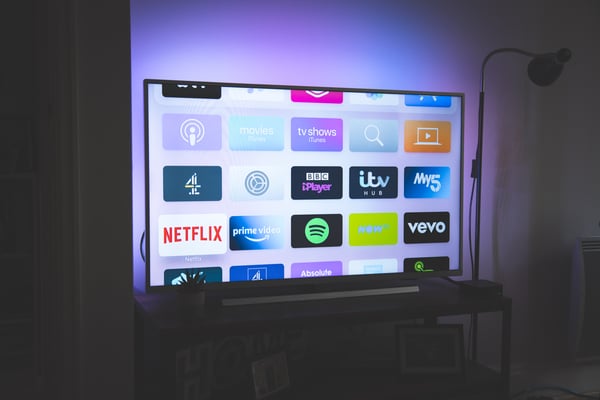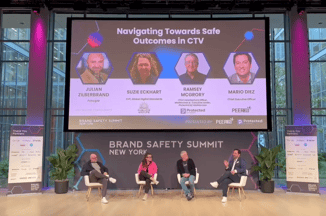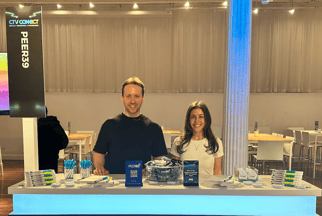Why Brand Suitability is Important in 2023 and Beyond

Daily digital media consumption is predicted to increase by nine minutes to eight hours and 23 minutes in 2023. That’s a lot of time spent reading articles, watching videos, listening to podcasts, and viewing shows and movies online. This is great news for the digital advertising industry. The opportunities for marketers to reach and engage consumers are virtually endless with so much of our lives now being spent online.
However, there is a downside to this explosion in internet content—risks to brand reputation if ad placements appear alongside unsavory or inappropriate content misaligned with brand values. Being affiliated with the wrong type of content can permanently damage a brand’s image. To prevent this potential threat, brand safety has become a huge focus in the ad tech ecosystem. As defined by the IAB, brand safety measures protect a brand’s reputation by avoiding ad placements near inappropriate content, such as hate speech, fake news, or extremist content.
Brand safety is often used interchangeably with the related term “brand suitability.” But the two terms actually differ in some key ways. Whereas brand safety is often focused on avoidance of unsavory or inappropriate content through tactics like blocklists and keyword exclusion lists, brand suitability takes a more nuanced approach that involves identifying types of content and sites with which specific brands are OK aligning. Pursuing brand suitability over traditional brand safety tactics means your brand can identify potentially high-quality placements that boost ad revenue instead of over-blocking certain content categories, keywords, topics, and publishers.
What Are Common Brand Suitability Concerns?
While there is a vast variety of content on the internet, there are a few main categories about which advertisers are generally wary when it comes to brand suitability. Here are six that come up a lot for advertisers aspiring to brand suitability.
- Fake news: Over the last six years, fake news content has exploded, often making it difficult for audiences to distinguish illegitimate from legitimate information. These fake publishers mean brands run the risk of running ad placements on what they think are real websites. Forty-one percent of social media users say platforms that show them deceptive content like fake news or disinformation affects their decision to engage with ads and sponsored content.
- Extremist content: Just like fake news, extremist content has overtaken the internet like kudzu and is commonly cited or shared on social media. In the second quarter of 2022, Facebook removed 13.6 million pieces of content containing terrorist propaganda from its platform. Brands should block these sites and avoid ad placements there—if they don’t, they are putting their ad spend directly towards radicalization.
- Hate speech: According to Freedom Forum, hate speech is “speech that offends or attacks people on the basis of race, ethnicity, national origin, religion, gender, sexual orientation, disability, disease, or other traits.” It’s technically protected by the First Amendment unless it “incites or is likely to incite imminent lawless action.” Rates of hate crime and hate speech both online and off have been increasing, with FBI hate crime incidents up nearly 13% between 2019 and 2020.
- War: While we can likely uniformly agree that the first three categories in this list should be flat-out avoided by advertisers, these next three are where you can really see the need for brand suitability. The war in Ukraine has sent many advertisers looking to block their ads from sites covering the event. This is one area in which using custom categories (more on that later) can help brands select an objective based on how comfortable they are with ads appearing alongside content related to the war. Brands can certainly decide to avoid any content related to Ukraine, regardless of the context, OR they can choose to avoid the negative aspects of the event, such as death, injury or military conflict, and terrorism, using contextual targeting brand suitability tools.
- Politics: Similar to way, politics is another category in which brands might want to consider a less restrictive approach based on the specific topic and context. A brand might want to avoid highly-polarizing political content but not all articles related to the broad category, such as election updates.
- Illegal drug use: Yes, illegal drug use is pretty straight-forward as a category, but there can still be some nuance when it comes to advertising around this content. For instance, there have been articles over the years about research into psychedelic-assisted therapy for use in mental health. If you are advertising in the healthcare industry, this could be suitable content for you to run on, but that wouldn’t be the case if you’re a toy retailer.
Why Brand Suitability Solutions Matter
As some of the statistics we shared above reveal, there is a potential major cost to brand reputation when running alongside the wrong content. According to the 2022 TAG/BSI US Consumer Brand Safety Survey:
- 81% would reduce purchasing a product they regularly buy if they discovered that the brand’s ads had appeared next to racist or hate speech
- 87% would reduce purchasing a product they regularly buy if they discovered that the brand’s ads had appeared next to terrorist recruiting videos
- 88% said it’s very or somewhat important that advertisers ensure their ads are not placed near brand-unsafe content
While preserving the safety of the internet surely requires a collective effort among not only advertisers, but all stakeholders in the digital media ecosystem, it’s clear that consumers themselves mostly put the onus on brands and agencies. With the world landscape as it is—COVID-19 and other health issues, economic uncertainty, war, contentious elections and claims of election fraud—brands will require an ongoing brand suitability strategy.
In addition, fast-growing digital advertising channels such as connected TV pose their own challenges. Many advertisers continue to buy on blind or opaque inventory due to an industry-wide issue with getting actual transparency into which inventory CTV buyers get. This is due to wide variations in data availability, inconsistent and indecipherable app data, and lack of industry-wide standards. The result is that many CTV ads wind up running on low-quality inventory such as user-generated content, non-professional video categories, screensavers, or mobile apps.
To ensure your ads consistently run in suitable environments, you must balance content concerns with surfacing context-appropriate content and publishers for your ads.
How Can Brand Suitability Impact Your Ad Spend?
Content doesn’t need to be hateful, misinformed, or extremist to be unsuitable for your brand. Other categories, such as anime, kids content, and user-generated content, can both cause concerns among consumers and waste your ad spend, especially in environments like CTV. When you don’t know where your ads are running, it’s impossible to know if they reached your target audience. This means it’s impossible to know if your ad spend was used wisely.
As the industry shifts away from behavioral targeting in the face of third-party cookie deprecation, Apple IDFA, and changes on Facebook and Twitter, recent studies show that there could be increased performance and advertising savings when using targeted, programmatic contextual advertising. Because contextual focuses on the most recent content consumed and its context versus a pair of shoes bought six months ago, it can be a more accurate indicator of intent to buy, in addition to an overall safer way of targeting ads to consumers.
A study with Dentsu Aegis Network showed that compared with similar third-party cookie ads:
- The eCPM for contextual ads was 36% less
- The CPC was 48% less
- The contextual vCPM was 41% less
Other research by Digiday shows that advertisers are beginning to shift their spend to contextual-based strategies:
- 61% expected to see an increase in buy-side budgeting for contextual-based campaigns
- 96% of advertisers said they were planning to spend as much or more on contextual advertising
- 65% of advertisers expected to add to their contextual-based budgets
Contextual solutions that leverage pre-bid targeting, by which publishers rely on unique segments and line items to ensure more appropriate ad targeting efforts and higher media quality, can save you money compared to post-bid targeting. The best pre-bid targeting solutions impart less competition on each impression due to up to 50% larger impression pools, reducing your overall media cost and shaving up to 20% off data costs. (You can read more about pre-bid segments powered by companies like Integral Ad Science (IAS) here.)
How Can Contextual Advertising Protect Your Brand?
Contextual advertising is not only a good financial decision, but can also help you balance brand safety and brand suitability while boosting performance.
Shifting your focus from where a user has been to where they currently are ensures that your ads are related to the content they’re consuming in real-time. By analyzing the keywords and content on the web page itself—rather than user browsing behavior or demographics—using machine learning and algorithms, you can more precisely target the right audience with the right ad. A contextual advertising approach is also underpinned by first-party data and privacy-safe third-party data, future-proofing your strategy for the cookieless future.
At Peer39, we analyze every element of a page—URL, page layout, page type, page quality, page signals, and more—so we can classify it in real time. Using artificial intelligence, natural language processing, and machine learning algorithms help our platform continually learn and make the best recommendations for running ads in suitable environments.
Sign up for a free transparency tag to understand where your ads are running.
More Posts

Disrupting the Status Quo in CTV at the Brand Safety Summit
Transparency is a cornerstone of Peer39's solutions—CTV and otherwise—so it made perfect sense for us to participate in the open and honest discussions at the Brand Safety Summit in New York City on October 29 and 30.

Navigating (or Staying Away From) the Political Media Storm During the 2024 Presidential Election
In the ever-evolving landscape of political media, the 2024 Presidential election stands out as a pivotal moment, marked by extensive candidate coverage, heated debates on crucial social and political issues, and an unprecedented outpouring of content. Brands, political campaign teams, and advertisers each need to know how to effectively navigate this political media storm while ensuring alignment with their messages and values.

Takeaways from CTV Connect 2025: CTV Expectations & Challenges
CTV Connect brought together over 500 decision-makers from across the entire Connected TV ecosystem for a two-day conference in New York City. With so much growth and rapid changes, there were lively conversations, panels, and roundtables around measurement, audience engagement, AI, budgeting strategies, and transparency.
